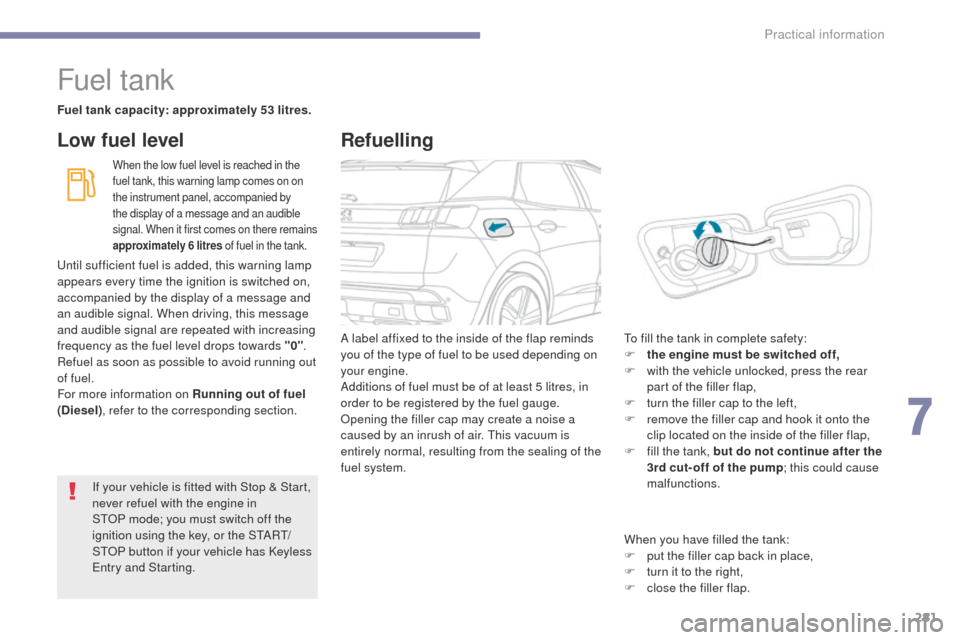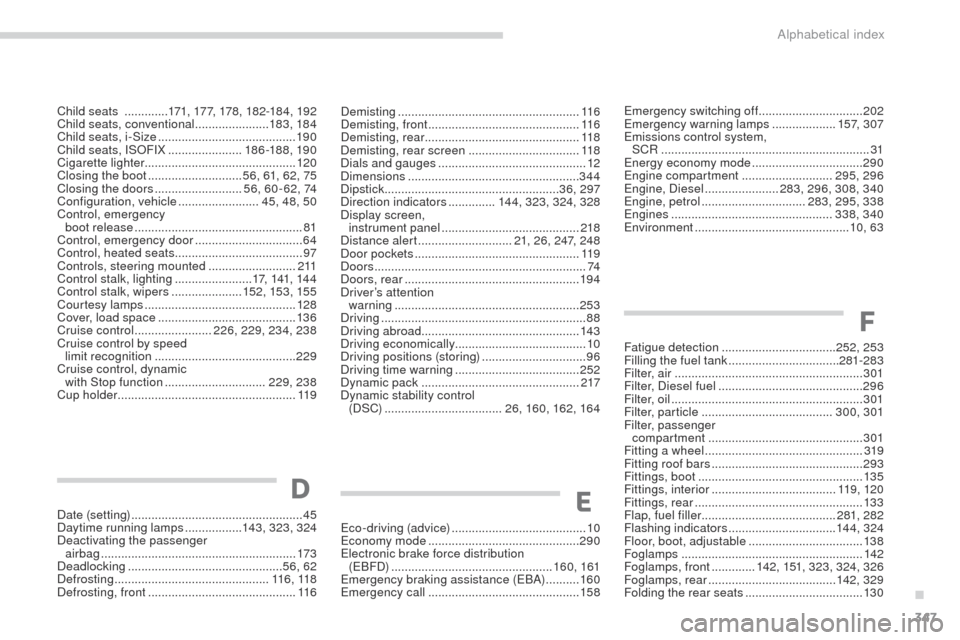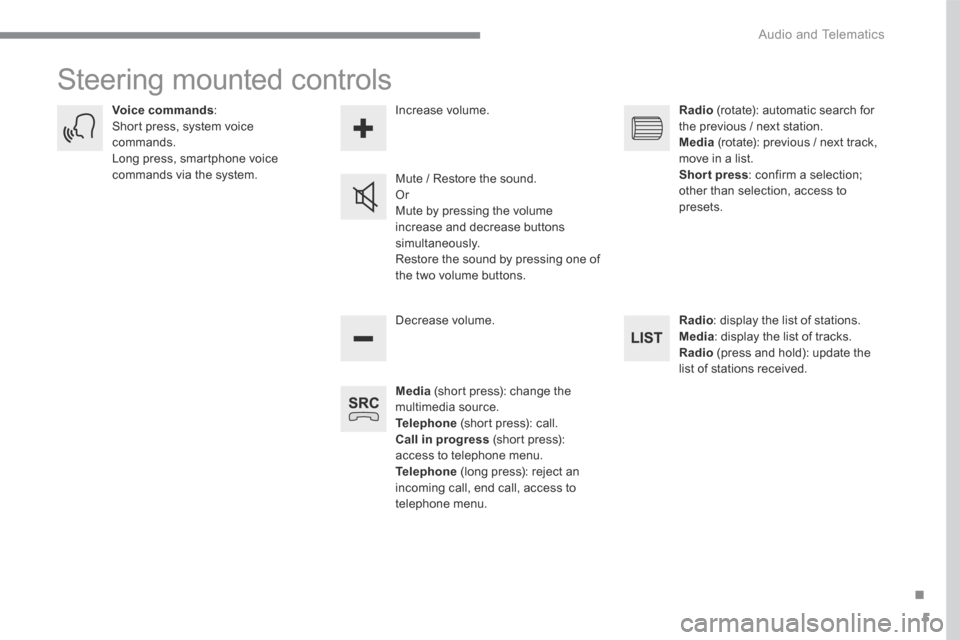2017 Peugeot 3008 Hybrid 4 display
[x] Cancel search: displayPage 281 of 566

279
3008-2_en_Chap06_conduite_ed01-2016
The system is deactivated by pressing the control.The system is deactivated automatically:
- o n switching off the ignition,
-
i
f the engine stalls,
-
i
f no manoeuvre is started within 5 minutes
of selection of the type of manoeuvre,
-
a
fter a prolonged stop of the vehicle during
a manoeuvre,
-
i
f the road wheel anti-slip regulation (ASR)
is triggered,
-
i
f the speed of the vehicle exceeds the
stated limit,
-
w
hen the driver interrupts movement of the
steering wheel,
-
a
fter 4 manoeuvre cycles,
-
o
n opening the driver's door,
-
i
f one of the front wheels encounters an
obstacle.
The operation indicator lamp goes off in the
instrument panel and a message is displayed
accompanied by an audible signal.
The driver should then take back control of the
vehicle's steering.
Deactivation
The system is switched off automatically:
- w hen towing a trailer, connected
electrically,
-
i
f the driver's door is opened,
-
i
f the speed of the vehicle is above 42 mph
(70 km/h).
To switch the system of for a prolonged period,
contact a PEUGEOT dealer or a qualified
workshop.
Operating faults
In the event of a fault with the power
steering, this warning lamp flashes in
the instrument panel, accompanied
by a message.
Contact a PEUGEOT dealer or a qualified
workshop.
Switching off
If the lateral distance between your
vehicle and the space is too great, the
system may not be able to measure the
space.
Anything projecting beyond the envelope
of the vehicle (a ladder on the roof, for
example) is not taken into account by the
Park Assist system during a manoeuvre.
In bad weather or in winter, ensure that
the sensors are not covered by road
dirt, ice or snow.
In the event of a fault, have the system
checked by a PEUGEOT dealer or a
qualified workshop.
If the system is deactivated during a
manoeuvre, the drive should reactivate
it to repeat the measurement. In the event of a fault, this warning
lamp flashes for a few seconds,
accompanied by an audible signal.
If the fault occurs during the use
of the system, the warning lamp
goes
off. High pressure jet washing
When washing your vehicle, keep the lance at
least 30 cm away from the sensors.
6
Driving
Page 283 of 566

281
3008-2_en_Chap07_infos-pratiques_ed01-2016
Fuel tank
Fuel tank capacity: approximately 53 litres.
When the low fuel level is reached in the
fuel tank, this warning lamp comes on on
the instrument panel, accompanied by
the display of a message and an audible
signal. When it first comes on there remains
approximately 6 litres of fuel in the tank.
Low fuel level
A label affixed to the inside of the flap reminds
you of the type of fuel to be used depending on
your engine.
Additions of fuel must be of at least 5 litres, in
order to be registered by the fuel gauge.
Opening the filler cap may create a noise a
caused by an inrush of air. This vacuum is
entirely normal, resulting from the sealing of the
fuel system. To fill the tank in complete safety:
F
t he engine must be switched off,
F
w
ith the vehicle unlocked, press the rear
part of the filler flap,
F
t
urn the filler cap to the left,
F
r
emove the filler cap and hook it onto the
clip located on the inside of the filler flap,
F
f
ill the tank, but do not continue after the
3rd cut- off of the pump ; this could cause
malfunctions.
If your vehicle is fitted with Stop
&
Start,
never refuel with the engine in
STOP
mode; you must switch off the
ignition using the key, or the START/
STOP button if your vehicle has Keyless
Entry and Starting.
Until sufficient fuel is added, this warning lamp
appears every time the ignition is switched on,
accompanied by the display of a message and
an audible signal. When driving, this message
and audible signal are repeated with increasing
frequency as the fuel level drops towards "0"
.
Refuel as soon as possible to avoid running out
of fuel.
For more information on Running out of fuel
(Diesel) , refer to the corresponding section.
Refuelling
When you have filled the tank:
F
p ut the filler cap back in place,
F
t
urn it to the right,
F
c
lose the filler flap.
7
Practical information
Page 349 of 566

347
3008-2_en_Chap11_index-alpha_ed01-2016
Demisting ......................................................11 6
Demisting, front ............................................. 11 6
Demisting, rear
.............................................. 11
8
Demisting, rear screen
.................................118
Dials and gauges
............................................ 12
Dimensions
................................................... 344
Dipstick
................
.................................... 36, 297
Direction indicators
..............14 4, 323 , 324, 328
Display screen, instrument panel
...............................
..........218
Distance alert
............................ 21, 26 , 247 , 248
Door pockets
................................................. 11
9
Doors
............................................................... 74
Doors, rear
.................................................... 19 4
Driver’s attention warning
...............................
........................253
Driving
............................................................. 88
Driving abroad ............................................... 143
Driving economically ....................................... 10
Driving positions (storing)
...............................96
Driving time warning
..................................... 252
Dynamic pack
..............................
.................217
Dynamic stability control (DSC)
................................... 26, 160 , 162, 16 4 Emergency switching off ...............................
2 02
Emergency warning lamps ................... 15
7, 307
Emissions control system, SCR
..............................................................31
Energy economy mode
.................................290
Engine compartment
...........................295, 296
Engine, Diesel
...................... 28
3, 296 , 308 , 340
Engine, petrol
...............................283, 295 , 338
Engines
................................................338, 340
Environment
...............................
...............10, 63
Child seats
.............
17
1
, 17 7 , 178 , 182-18 4 , 192
Child seats, conventional
...................... 183, 18 4
Child seats, i-Size
...............................
.......... 19 0
Child seats, ISOFIX
...................... 18
6 -188 , 19 0
Cigarette lighter ............................................. 120
Closing the boot
............................ 56, 61 , 62 , 75
Closing the doors
.......................... 56, 60-62 , 74
Configuration, vehicle
........................ 45, 48 , 50
Control, emergency boot release
.................................................. 81
Control, emergency door
................................ 64
Control, heated seats
...................................... 97
Controls, steering mounted
.......................... 2 11
Control stalk, lighting
....................... 17,
141 , 14 4
Control stalk, wipers
..................... 152, 153 , 155
Courtesy lamps
............................................. 128
Cover, load space
......................................... 13
6
Cruise control
....................... 2
26 , 229 , 234 , 238
Cruise control by speed limit recognition
.......................................... 229
Cruise control, dynamic with Stop function
.............................. 229, 238
Cup holder
...............................
...................... 11 9
F
Fatigue detection .................................. 252, 253
Filling the fuel tank ................................. 28
1-283
Filter, air
...............
......................................... 301
Filter, Diesel fuel
........................................... 296
Filter, oil
......................................................... 301
Filter, particle
....................................... 300, 301
Filter, passenger compartment
.............................................. 3
01
Fitting a wheel
...............................
................319
Fitting roof bars
............................................. 293
Fittings, boot
................................................. 13
5
Fittings, interior
..................................... 11 9, 120
Fittings, rear
...............................
...................13 3
Flap, fuel filler
...............................
.........281, 282
Flashing indicators
................................ 14 4, 324
Floor, boot, adjustable
..................................13 8
Foglamps
...................................................... 142
Foglamps, front
.............142, 151 , 323 , 324, 326
Foglamps, rear
...................................... 142, 329
Folding the rear seats
...................................13 0
D
Date (setting) ............................... ....................45
Daytime running lamps .................143, 323 , 324
Deactivating the passenger airbag
.......................................................... 17
3
Deadlocking
.............................................. 56, 62
Defrosting
.............................................. 11 6, 118
Defrosting, front
............................................ 11
6E
Eco-driving (advice) ........................................ 10
Economy mode ............................................. 290
Electronic brake force distribution (EBFD)
................................................ 160, 161
Emergency braking assistance (EBA)
.......... 16
0
Emergency call
............................................. 15
8
.
Alphabetical index
Page 361 of 566

1
.
Audio and Telematics
Transversal-Peugeot_en_Chap01_NAC-2-2-0_ed01-2016
PEUGEOT Connect Nav
GPS satellite navigation - Applications - Multimedia audio - Bluetooth ® GPS satellite navigation - Applications - Multimedia audio - Bluetooth ® GPS satellite navigation - Applications - Multimedia audio - Bluetooth telephone ® telephone ®
Contents First steps 2
Steering mounted controls 5
Menus 6
Voice commands 8
Navigation 14
Connected navigation 30
Applications 40
Radio Media 56
Telephone 68
Settings 80
Frequently asked questions 90
The system is protected in such a way that it will only operate in your vehicle. Displaying of the Energy Economy Mode message signals that a change to standby is imminent.
The different functions and settings described vary according to the version and configuration of your vehicle.
The link below gives access to OSS (Open Source Software) codes for the system. http://www.psa-peugeot-citroen.com/oss
As a safety measure and because it requires sustained attention by the driver, the pairing of a Bluetooth mobile telephone with the Bluetooth hands-free system of your audio system must be done with the vehicle stationaryand the ignition on.
Page 363 of 566

3
.
12:13
18,5 21,5
23 °C
Audio and Telematics
Transversal-Peugeot_en_Chap01_NAC-2-2-0_ed01-2016
Select the audio source (depending on version): - FM / DAB * / AM * radio stations. - USB memory stick. - CD player. - Media player connected via the auxiliary socket (Jack, cable not supplied). - Telephone connected by Bluetooth * using
Bluetooth * audio streaming.
* Depending on equipment.
Certain information is displayed permanently in the upper band of the touch screen: - Reminder of the air conditioning information and direct access to the corresponding menu. - Go directly to the selection of the audio source, to the list of radio stations (or list of titles depending on the source).
- Go to the message notifications, emails, map updates and, depending on the services, the navigation notifications. - Go to the settings for the touch screen and the digital instrument panel.
In very hot conditions, the volume may be limited to protect the system. It may go into standby (screen and sound off) for at least 5 minutes.
The return to normal takes place when the temperature in the passenger compartment has dropped.
In the "Settings" menu you can create a profile for just one person or a group of people with common points, with the possibility of entering a multitude of settings (radio presets, audio settings, navigation history, contact favourites, ...); these settings are taken into account automatically.
Page 365 of 566

5
.
Audio and Telematics
Transversal-Peugeot_en_Chap01_NAC-2-2-0_ed01-2016
Steering mounted controls
Media (short press): change the multimedia source. Telephone (short press): call. Call in progress (short press): access to telephone menu. Telephone (long press): reject an incoming call, end call, access to telephone menu.
Decrease volume.
Voice commands : Short press, system voice commands. Long press, smartphone voice commands via the system. Mute / Restore the sound. Or Mute by pressing the volume
increase and decrease buttons simultaneously. Restore the sound by pressing one of the two volume buttons.
Radio (rotate): automatic search for the previous / next station. Media (rotate): previous / next track, move in a list. Short press : confirm a selection; other than selection, access to presets.
Radio : display the list of stations. Media : display the list of tracks. Radio (press and hold): update the list of stations received.
Increase volume.
Page 367 of 566

7
.
FM/87.5 MHz
87.5MHz
12:13
18,5 21,5
23 °C12:13
18,5 21,5
23 °C12:13
18,5 21,5
23 °C
Audio and Telematics
Transversal-Peugeot_en_Chap01_NAC-2-2-0_ed01-2016
Settings Radio Media Telephone
Configure a personal profile and/or configure the sound (balance, ambience, ...) and the display (language, units, date, time, ...).
Select an audio source, a radio station, display photographs. Connect a telephone by Bluetooth ® , read messages and emails and send quick messages.
Page 368 of 566

8
Audio and Telematics
Transversal-Peugeot_en_Chap01_NAC-2-2-0_ed01-2016
Voice commands
First steps Steering mounted controls Information - Using the system
Press the Push To Talk button and tell me what you'd like after the tone. Remember you can interrupt me at any time by pressing this button. If you
press it again while I'm waiting for you to speak, it'll end the conversation. If you need to start over, say "cancel". If you want to undo something, say "undo". And to get information and tips at any time, just say "help". If you ask to me do something and there's some information missing that I need, I'll give you some examples or take you through it step by step. There's more information available in "novice" mode. You can set the dialogue mode to "expert" when you feel comfortable.
To ensure that voice commands are always recognised by the system, please observe the following recommendations: - speak in a normal tone without breaking up words or raising your voice. - always wait for the "beep" (audible signal) before speaking. - for best operation, it is recommended that the windows and opening roof be closed to avoid extraneous interference (according to version). - before making a voice command, ask other passengers to not speak.
The voice commands, with a choice of 12 languages (English, French, Italian, Spanish, German, Dutch, Portuguese, Polish, Turkish, Russian, Arabic, Brazilian), are made using the language previously chosen and set in the system.
The voice commands in Arabic for: "Navigate to address" and "Display POI in the city", are not available.
Alternative synonyms can be used for some voice commands. E.g. Guide to / Navigate to / Go to / ...
Example of a "voice command" for navigation: "Navigate to address 11 Regent Street, London" .
Example of a "voice command" for the radio and media: "Play ar tist Madonna" .
Example of a "voice command" for the telephone: "Call David Miller" .
Pressing this button activates the voice commands function.